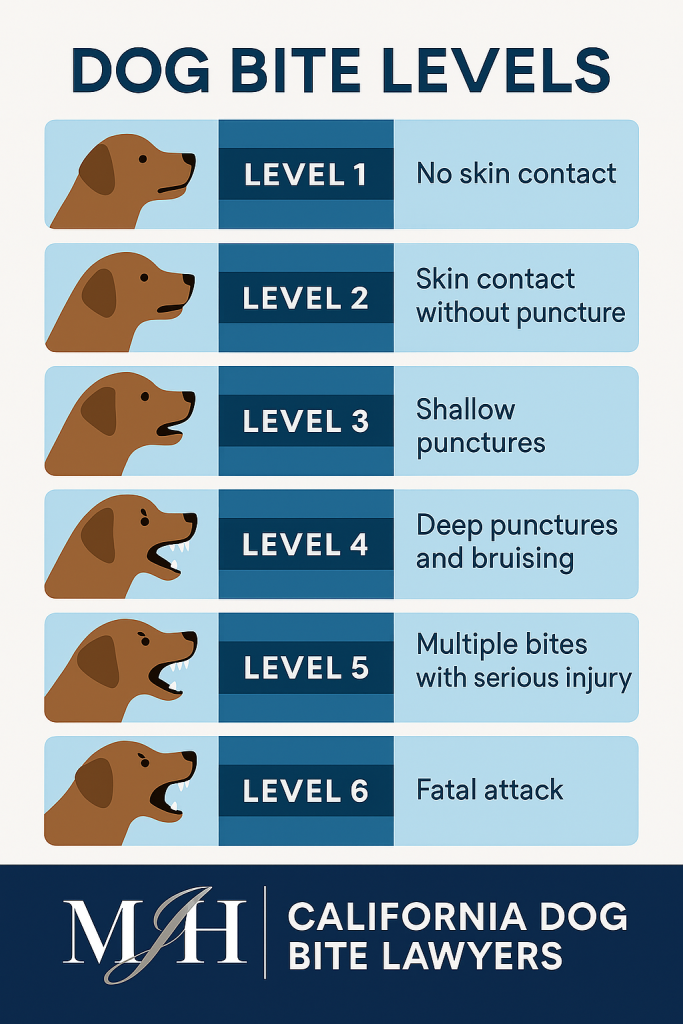Understanding the severity and implications of a dog bite is crucial for victims, medical professionals, and attorneys navigating personal injury claims. This chart offers a comprehensive visual representation of bite classifications based on the widely accepted Dunbar Bite Scale.

This scale categorizes dog bites from Level 1 to Level 6, allowing for accurate assessment of physical trauma, legal liability, and potential compensation under California law.
Level 1: Pre-Bite Warning — No Skin Contact
Level 1 bites aren’t technically bites at all. They occur when a dog exhibits threatening behavior—such as snarling, growling, or snapping—without making physical contact. While the victim remains physically unharmed, this level is not without consequence. The emotional impact, especially if directed at a child or elder, may warrant reporting or intervention. California law typically does not allow financial recovery for Level 1 incidents unless psychological harm or reckless owner behavior is proven.
Level 2: Nipping Contact — Skin Touched but No Puncture
Level 2 bites involve the dog’s teeth contacting the skin but not breaking it. These may result in light bruising, scratches, or shallow impressions that heal quickly. Though medical treatment is minimal—usually limited to cleaning the area and monitoring for infection—Level 2 bites can support a personal injury claim in California if emotional distress, fear of dogs, or repeat aggression is involved. Settlement amounts for this level commonly range from $20,000 to $50,000, based on medical documentation and non-economic damages.
Level 3: Minor Punctures — Shallow Wounds, No Deep Tissue Damage
A Level 3 bite is defined by one to four puncture wounds from a single bite. None of the punctures penetrate deeper than half the length of the dog’s canine teeth. These wounds may require antiseptics, bandages, and prescription antibiotics. Treatment costs, time off work, and psychological counseling (especially for children) drive the value of claims in this category. Typical settlements in California range from $2,500 to $10,000, with the upper end reflecting particularly traumatic circumstances or vulnerable victims.
Level 4: Deep Puncture Wounds with Bruising or Tearing
When a bite penetrates deeply—more than half the length of a dog’s canine tooth—and causes visible bruising or tearing, it’s classified as Level 4. Such injuries may result in nerve damage, infections, or permanent scarring. Victims often require stitches, surgery, and physical therapy. The chart illustrates this level with bold indicators and emphasizes that these injuries are moderate to severe. Settlement values typically fall between $10,000 and $50,000 depending on extent of disfigurement, recovery duration, and psychological impact.
Level 5: Multiple Severe Bites — Crushing, Tearing, and Extensive Damage
Level 5 bites represent aggressive, sustained attacks involving multiple bites with deep tissue damage. Victims may suffer muscle lacerations, tendon damage, permanent disability, or disfigurement. These cases often involve emergency surgeries, long-term rehab, and mental health treatment for PTSD or fear-based disorders. In the chart, Level 5 is displayed with high-alert color coding and stark visuals to convey severity. California settlement ranges often begin around $50,000 but can exceed $150,000 when permanent damage or professional impairment is proven.
Level 6: Fatal Attacks
The highest level of the chart addresses tragic cases where a dog bite results in death. Though rare, these incidents prompt wrongful death claims under California Civil Code and frequently include compensation for funeral costs, loss of financial support, and emotional suffering for surviving family members. Visual cues in the chart mark Level 6 with somber tones and clearly distinguish it from other injury levels. Settlements often range from $250,000 to several million dollars, depending on the age of the victim, family structure, and evidence of gross negligence or prior aggression.
Legal Significance in California
Each bite level carries unique legal consequences under California’s strict liability statute (Civil Code § 3342). Owners are legally responsible for injuries caused by their dogs in public or private settings, regardless of the dog’s history. The chart incorporates this legal framework into its design, pairing each bite level with corresponding legal risk and financial exposure.
Higher-level bites (Levels 4–6) often trigger mandatory reporting to animal control, may lead to quarantine orders, and can result in the classification of the dog as “potentially dangerous” or “vicious.” These outcomes are visualized alongside the bite categories in the chart’s right-hand columns.
Value as a Legal and Medical Tool
Created for use by attorneys, claim adjusters, and victim advocates, this chart acts as a hybrid reference for assessing physical injury, psychological harm, and economic damages. It’s especially useful during:
- Intake interviews for dog bite victims
- Settlement negotiations with insurers
- Court presentations for jury education
- Pediatric evaluations in child injury cases
- Expert testimony coordination with medical specialists
Final Thoughts
The “Dog Bite Level Chart” offers more than a scale—it’s a practical guide to justice and care. Whether used by a personal injury lawyer assessing case value or a medical provider triaging bite wounds, its systematic layout helps stakeholders understand how injury severity translates into legal accountability and victim compensation. California’s commitment to strict liability is mirrored in the chart’s structure, reinforcing the principle that public safety, prevention, and fair restitution are non-negotiable.
Need a California Dog Bite Legal Analysis?
If you or a loved one has suffered a dog bite injury in California you don’t have to go through the legal process alone as a skilled dog bite lawyer at the Law Offices of Melinda J. Helbock can help you understand your rights, deal with insurance companies, and fight for the compensation you deserve.
Contact us today for a free consultation and let us help you get the justice and financial recovery you need.





